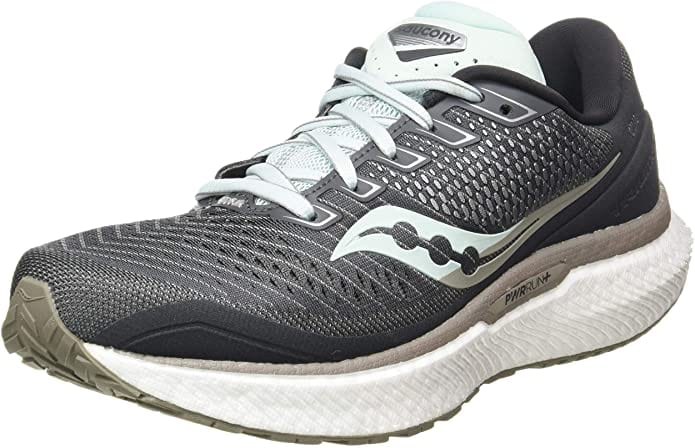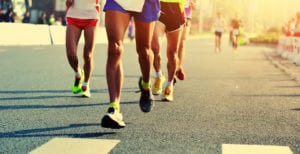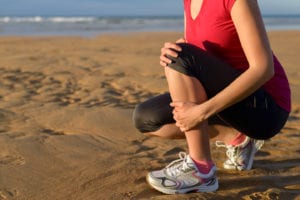- Alan Martin
So, you’ve got wide feet. Odds are, you’ve searched and searched, and you just cannot for the life of you find a well-fitting Running shoe with good comfort and support.
You might get discouraged, but believe me, it’s not time to give up and go running barefoot down the road. There are some manufacturers out there that recognize how prevalent wide-footed runners are.
Below you’ll find some of the best, tried-and-true running shoes for wide feet on the market. They’ve guaranteed a secure fit for runners with wide feet and specialized support throughout the gait cycle with balanced, responsive rides. Read on for the details.
Best Sneakers for Wide Feet
1. HOKA ONE ONE Clifton 7 Road Running Shoe

The Clifton 7 retained many of the most favorable qualities of past versions and enhanced them further, specifically in the full-compression EVA midsole and soft, responsive ride.
It features HOKA’s Meta-Rocker technology, contributing to a smooth ride and reducing your “plantar force” (the amount of pressure present between your foot and the ground), thus lowering your chances of injury.
This pair of shoes has a small drop at only 5 mm and weighs 8.70 oz (men) or 7.10 oz (women). Plus, it’s available in wide (D for women, EE for men) to accommodate those with wide feet.
Pros
- Upper sandwich mesh is flexible while retaining maximal breathability (includes gusset to keep the tongue in place)
- Early stage Meta-Rocker and full-compression EVA midsole provide bouncy, smooth ride with balanced cushioning
- Rear elf ear and Achilles tab for easy put on, easy take off
- American Podiatric Medical Association (APMA) Seal of Acceptance
- Springy bounce which helps propel runners
Cons
- Very cushioned and padded (can make faster paces difficult)
- "Elven" style Achilles pressure-relieving heel tab can be a bit annoying for some
2. New Balance Fresh Foam 1080v10 Road Running Shoe

The feature that is immediately noticeable upon seeing and wearing this New Balance 1080v10 shoe is the aggressive rocker design.
As mentioned previously, this characteristic is especially beneficial for those with plantar fasciitis since it helps relieve excess pressure and supports a smooth heel-to-toe transition.
Of course, apparent in the name, this pair of shoes features NB’s Fresh Foam X, a fresh take on the traditional EVA midsole, designed for ultra-cushioning without any extra weight.
The midsole also integrates NB’s ABZORB blend, a type of foam cushioning and compression set that integrates rubber for a nice, springy ride.
The 1080v10 (8 mm drop, 9.5 oz for men, 8.4 oz for women) is available in wide (E, 2E, EE), extra-wide (3E+), and extra-extra wide (5E+) sizes.
SEE ALSO: New Balance Fresh Foam 1080v11
Pros
- HYPOKNIT upper is structurally supportive yet flexible and accommodates wide feet
- Rubber outsole increases durability
- Fresh Foam X and ABZORB create a fantastic, responsive ride
- Rocker bottom design is excellent for plantar fasciitis
- Excellent for long-distance running
- Available in multiple color options
Cons
- Collar fit can be finicky and irritate the ankles
- The size tends to run small
3. Altra Torin 4.5 Plush Road Running Shoe

This updated model integrates the premium Quantic™ midsole (excellent flexibility and shock absorption) and FootPod™ outsole (maps your foot’s anatomy for optimal fit and mobility) you experienced in previous versions, offering that familiar, responsive, smooth ride.
The most important trait to note is that it is a zero-drop shoe (shout out to my forefoot and midfoot strikers!). Yet, these athletic shoes have a 28 mm stack height for ample underfoot cushioning.
The Torin 4.5 Plush (9.1 oz for men, 7.4 oz for women) also features Altra’s signature FootShape™ technology, allowing your toes to spread out naturally and comfortably to maximize stability even when running on uneven terrain.
Pros
- FootPod™ and FootShape™ technology optimize fit to your specific foot shape
- Quantic™ midsole provides excellent support and flexibility
- New engineered knit upper for excellent breathability
- Zero drop design increases running efficiency
- Great cushion while still providing great rebound
Cons
- You might have to adjust your stride to get comfortable with the ride
- Tongue is a bit short
4. Brooks Ghost 13 Road Running Shoe

Brooks’ newest Ghost model, the Ghost 13, is heavily cushioned, featuring their DNA LOFT technology throughout the midsole for an optimal heel-to-toe transition.
This shoe also features Brooks’ Segmented Crash Pad, a “caterpillar” shaped system of fully integrated shock absorbers designed to accommodate a wide range of foot shapes and optimize each wearer’s ride.
It’s got a high drop at 12 mm, so it’s excellent for heel strikers. This neutral shoe weighs 10.1 oz for men and 8.8 oz for women and is available in wide (2E for men and D for women) and extra-wide (4E for men) sizes.
SEE ALSO: Brooks Ghost 13 GTX
Pros
- Excellent for people with high and medium arches
- Combination of DNA LOFT tech, Segmented Crash Pad, and 12 mm drop promotes smooth heel-to-toe transition, creating a comfortable ride
- AirMesh on the upper is highly breathable
- OmegaFlex groove for maximum flexibility
Cons
- Short life expectancy ~ 300 to 500 miles
- Reduced cushioning over time
5. HOKA ONE ONE Bondi 7 Road Running Shoe

The low-drop (4 mm) Bondi 7 (10.70 oz men, 8.90 oz women) features HOKA’s signature Meta-Rocker technology. You can also expect a smooth, responsive ride from the full-length, compression-molded EVA midsole.
The Bondi 7 has a beveled heel design, improving your landing by minimizing the impact on the heel. This provides substantial support, especially due to its pairing with the padded internal heel counter and memory foam collar, keeping your foot comfy and anchored to that midsole.
The TPU (thermoplastic urethane) overlay provides additional support on the midfoot. If you’ve got wide feet, this can accommodate you, as it’s available in many wide sizes: D, EE, 4E.
Pros
- Low 4mm drop adds stability for overpronators and those with low arches
- Excellent support around the heel and ankle thanks to the beveled heel design, internal heel counter, and memory foam collar
- TPU overlay adds support to midfoot
- Meta-Rocker design supports natural gait cycle
- Great cushion from EVA foam and 30mm stack height
Cons
- The TPU overlay causes the upper to feel a bit restrictive
- Not as soft as some other ‘max-cushion’ offerings
6. Asics GT-2000 9 Road Running Shoe

Right out of the gate, Asics wants runners to feel the newly-designed upper in the GT-2000 9, maximizing support in key areas on the midfoot at each point throughout the gait cycle.
For the bottom of your foot, they’ve integrated a blend of their new FLYTEFOAM ® (approximately 55% lighter and 76% better cushioning) and GEL ® (reduces the impact on heel strikes and absorbs shock on forefoot strikes) tech to optimize cushioning for an amazingly comfortable ride with minimal shock impact.
This shoe has a 10 mm drop and weighs 7.8 oz for women and 9.9 oz for men. It’s available in D, 2E, and 4E sizes.
Pros
- Integrates rearfoot and forefoot GEL ® technology to support toe-off and absorb shock
- One-piece, no-sew mesh upper offers maximal support throughout the gait cycle
- Integrates GUIDANCE TRUSSTIC™ and DYNAMIC DUOMAX™ for an efficient toe-off
- Lightweight midsole
Cons
- Cushioning doesn't have as much give as you might expect
- Not a lot of flexiblity
- Limited color options for 4E and 2E
7. New Balance Fresh Foam 860v11 Road Running Shoe

This 10 mm-drop shoe features New Balance’s famous Fresh Foam technology in the two-part midsole for a balanced, ultra-cushioned ride.
One of the 860v11’s unique features is the medial post. This EVA component is located within the midsole, which is firmer than the rest of this shoe to provide incredible stability.
Note that this stability shoe is relatively heavy, weighing in at 11.4 oz for men (as opposed to the optimal 10 oz or less for the average wide running shoe, according to the American College of Sports Medicine). Women’s shoes are lighter at 9.6 oz, and both are available in wide and extra-wide sizes.
Pros
- Exceptional durability thanks to the blown rubber outsole
- Support all throughout the shoe due to the medial post, well-fitting engineered mesh upper, and data-driven cushioning
- Ultra Heels hugs the foot for a secure fit
- Has good stability in the sole
Cons
- Midsole can become hard after constant running
- Tight fit in the ball of the foot
8. Asics Gel-Cumulus 22 Road Running Shoe

This 10 mm-drop Asics shoe features the brand’s signature FLYTEFOAM ® technology, promoting a more “pillowy” ride and added support up through the toe-off.
Asics redesigned the shoe’s under-heel section, with deeper flex grooves (typically associated with the forefoot outsole) in the heel design for better support.
Speaking of the outsole, Asics integrated their hard-wearing AHAR ® rubber compound in this component in high-impact points to enhance the shoe’s durability and extend its lifespan.
Of course, what would the Gel-Cumulus 22 be without their GEL ® technology? This feature mitigates shock impact and helps improve movement.
You can buy this wide-width shoe in many sizes, including D, 2E, and 4E.
Pros
- FLYTEFOAM ® and GEL ® tech offer a super-soft ride, excellent for use as a daily trainer
- Lightweight and breathable due to mesh upper
- AHAR ® rubber outsole enhances durability
- 3D foot upper provides support and the right amount of flex
Cons
- May be a bit narrow for some
- Heel construction might be irritating for some wearers
9. Brooks Adrenaline GTS 20 Road Running Shoe

One of the premier features of the Adrenaline GTS 20 is the GuideRails support system. This feature reduces excess rotation in the shin and heel, supporting optimal knee motion to reduce pain and injury risk.
Your feet will also benefit from the support provided by Brooks’ BioMoGo DNA (an adaptive midsole material that offers dynamic cushioning, according to your body) and DNA LOFT Crash Pad. Together, these add a bit of spring to the ride, keeping you running at top-performance mile after mile.
This comfortable shoe has a large 12 mm drop and weighs 10.6 oz for men and 9.4 oz for women. It’s available in wider widths; D, 2E, and 4E.
SEE ALSO: Brooks Adrenaline GTS 21
Pros
- DNA LOFT and BioMoGo DNA provide dynamic support that adapts to your body size and weight
- GuideRails system reduces the risk of knee injury
- 3D Fit Print offers lightweight structural support
Cons
- Compared to past models, this sole is significantly less soft
10. New Balance Fresh Foam 880v10 Road Running Shoe

The lightweight (5.5 oz for girls and boys) New Balance 880v10 boasts an “unmatched” underfoot feel, thanks to the inclusion of the Fresh Foam technology in the midsole. This creates an ultra-cushioned ride that offers balanced, lightweight support to keep you going comfortably and confidently.
Since this tech is combined with the engineered HYPOKNIT upper, you’ll have support around your entire foot.
Plus, the molded external heel counter will help you maintain control of heel movement, optimizing your performance on the run.
Anyone who needs an wide or extra-wide shoe, New Balance has got you covered.
Pros
- Integrates Fresh Foam technology in the midsole for a soft yet responsive ride
- HYPOKNIT upper helps maintain structural support without compromising flex and breathability
- External heel counter provides welcome support
Cons
- Shoe may wear quickly; some runners reported material separating from sole
11. Mizuno Wave Inspire 16 Road Running Shoe

The integrated MIZUNO WAVE ® plate helps disperse energy upon impact, distributing the force across the foot to increase stability and enhance the benefits of the cushioning.
They’ve also integrated the U4ic midsole into the Wave Inspire 16, which mitigates shock and supports the ride’s responsiveness. The lightweight material also works alongside the SmoothRide technology, which helps a smooth transition from heel to toe with every stride.
Mizuno assures runners that this wide shoe will last for many miles, primarily because of the X10 outsole (a resilient material composed of durable carbon rubber).
This supportive shoe has a 12 mm drop, weighs 10.1 oz for men and 8.5 oz for women, and is available in D and 2E widths.
SEE ALSO: Mizuno Wave Inspire 17
Pros
- Reduces the force of impact you experience on the foot thanks to the MIZUNO WAVE ® plate
- U4ic midsole provides a responsive, balanced ride
- X10 outsole is highly durable
- Removable insole to accommodate custom orthotics
Cons
- Not great energy return
- Can feel a bit heavy
12. Saucony Triumph 18 Road Running Shoe

The Triumph 18 features numerous upgrades that are designed to improve the quality and duration of your runs – and perhaps even your speed at the same time.
How in the world is a shoe supposed to make you faster? Well, it’s probably in part due to the midsole upgrades that give a springier, snappier ride. The midsole features Saucony’s PWRRUN+ technology that’s 25% lighter with added flexibility and resilience. (The outsole’s rubber doesn’t hurt either.)
Plus, the TRIFLEX quickens your transitions through the gait cycle and enhances the shoe’s flexibility. With the FORMFIT system, you’ll enjoy a snug fit that optimizes your mobility.
This 8 mm-drop cushioned shoe is a bit hefty at 11.1 oz for men, but it’s 9.7 oz for women. It is available two wide options: D and 2E.
Pros
- PWWRUN+ and TRIFLEX technology create a springy, snappy ride
- FORMFIT system locks in heels
- 3D Print upper provides structural support and balanced flexibility
- Outsole has great traction on rough terrain
- Maximum padding and stack height (32.5mm back/24.5mm front)
Cons
- Seems Saucony lost focus on breathability in the upper
- Overly thick tongue
How To Buy the Best Running Shoes for Wide Feet
Now, let’s get down to it: How are you supposed to buy shoes for wide feet? I’m not sure why it’s such a headache to find footwear for wider feet, especially since it’s not a rare characteristic.
I mean, people aren’t only born with wide feet. In fact, your feet can get wider and longer as you age since the ligaments grow looser over time.
Still, whether you were born this way or not, you’ll need a wide shoe option with extra support – and it shouldn’t just be in the toe box. So, when you’re shopping, I recommend you have a careful look at the traits below so that you don’t wind up in the 63-72% of people stuck with incorrectly fitting footwear:
- Width: Of course, this is the most important feature you’ll be looking for. Look for running shoes that are available in sizes “wide” and “extra-wide,” usually denoted as “D” for women and “2E/4E” for men. (Larger sizes have a lot more Es.) If the width isn’t right, this could lead to some severe foot problems, even deformities.
- Note: Make sure you’re not only looking at the toe box! A wide toe box is beneficial, but this is likely not the only wide part of your foot. Typically, this spans across the forefoot and the midfoot, so you need these parts of a sneaker to accommodate you as well (a flexible upper and supportive midsole are ideal). With that said, for runners with a wide toe box and a narrow foot, they don’t need running shoes that are wide throughout.
- Proper Fit: It can be incredibly annoying to finally find a shoe that works for your foot’s width, only to discover that the upper is too rigid or tight or that the heel is loose and irritating. Many shoes offer a 3D Print upper, which can be great for structural integrity but might be rigid without added features like Saucony’s FORMFIT system. Also, for a perfect fit, it’s important to have the correct shoe size when shopping.
- Comfort: Several features can add to or work against comfort for wide running shoes. First, check your arch and strike pattern. Some wide-footed runners also have low or no arches due to the weakened, aging tendons. This might necessitate low or zero-drop shoes. Note other factors like shock absorption, beveled heels, and heel counters.
- Note: Weakened tendons can also lead to Flat feet, so your arch my lower as you age, too.
Frequently Asked Questions
How Do I Know if I Have Wide Feet?
Here’s how to check if you have fat feet:
- Slip on a pair of socks.
- Take two pieces of white paper and tape them to the floor. (Of course, this will be easier on tile, hardwood, etc., basically anything that isn’t carpet.)
- Trace the shape of your foot onto the paper or have someone do this for you.
- Measure the widest part of your foot on the drawing.
The shortcut: Have someone measure your foot width by simply holding up a ruler to the bottom of your foot.
There’s no hard rule on this, but most agree that if your foot is 4 1/16+” in a size 9 (women) or 4 5/16+” in a 10.5 (men), then you have wide feet.
How Wide Should Running Shoes Be?
There isn’t a single standard for how wide running shoes should be because runners have all different foot shapes and widths. For all feet, the shoe should fit snugly enough to prevent the foot from moving or sliding around inside. The most important things to pay attention to:
- You should be able to spread your toes.
- Your foot should not feel constricted at all.
- The shoe should cup your heel comfortably.
If you doubt whether it’s the correct width, try pinching the material on the sides and top. You should be able to grip a bit of the fabric.
Is It Better for Running Shoes To Be Tight or Loose?
Honestly? Neither. Your shoe should never be tight because it can restrict your blood flow and enhance the effect of impact with each step.
On the other hand, a loose-fitting shoe could slip off and lead to injuries. Plus, you won’t get a snug fit, negating the benefits of any added ergonomic features.
How Do You Know if Your Running Shoes Are Too Wide?
You can tell that a pair of running shoes are too wide if you have too much space to wiggle your foot around during use. If you’re still uncertain, note the presence of any blisters that might pop up, specifically on the ball of your foot. This will confirm that your shoes are too wide for your feet.
Conclusion
Having wider feet isn’t a bad thing. The worst part about it? Finding a shoe that fits! Thankfully, leading athletic footwear manufacturers have taken notice of how tricky it is to find a pair that suits you. So, they’ve offered their most dependable models to fit different foot types just right.
If you’ve been stuck looking for wide shoes with no luck, this list is chock-full of the best running shoes for wide feet on the market that’ll give you precisely what you need in terms of fit, ride, and longevity.
So, ready to hit the ground running? Pick from any of these top-of-the-line models listed above, and you’ll never have to worry about squeezing your foot into a standard-width shoe again.











